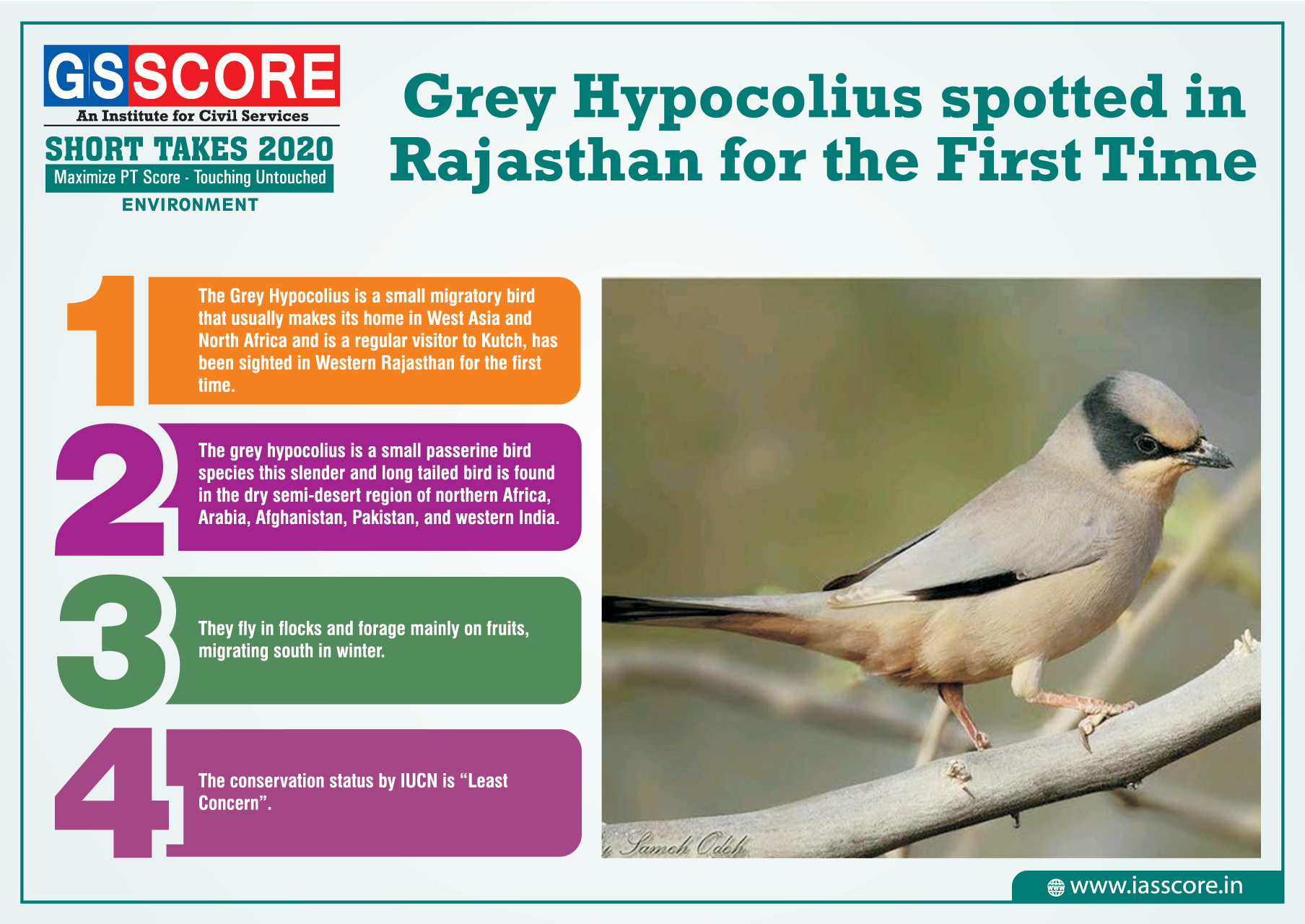History: Advent of different powers in India
Zoonoses

Orange-bellied ‘starry dwarf frog

Grey Hypocolius spotted in Rajasthan for the first time

Orcas (Killer Whale)

Velvet Worm

Pandit Deendayal Upadhyaya
Context
103rd birth anniversary of Pandit Deendayal Upadhyaya.
About
- Deendayal's personal life:
- Deendayal Upadhyaya was born in a village near the Farah town in Mathura district called Chandrabhan, which later went on to be named after him as “Deendayal Dham”.
- His father's name was Bhagwati Prasad, an astrologer, and his mother Rampyari was a religious woman.
- Both his parents died when he was only eight years old and he was then brought up by his maternal uncle and aunt who took care of him and his education as well.
- Education of Deendayal Upadhyaya:
- He completed his intermediate education at Birla College, Pilani, and his Bachelors in Arts at Sanatan Dharma College, Kanpur, in 1939. At this college, he came into contact with the Rashtriya Swayamsevak Sangh (RSS) through his classmate Baluji Mahashabde.
- He further joined St John's College in Agra to pursue a master's degree in English literature, but didn't complete it.
- Upadhyaya as a writer:
- Deendayal Upadhyaya first started the monthly “Rashtra Dharma” from Lucknow in the 1940s, meant for spreading the ideology of Hindutva nationalism.
- Later on, he also started the weekly “Panchjanya” and then the daily “Swadesh”.
- He edited the weekly and daily from Kanpur itself.
- He wrote a Hindi drama on Chandragupta Maurya, a biography of Shankaracharya, and translated a Marathi biography of Hedgewar.
- Deendayal and the Bharatiya Jana Sangh:
- After meeting the RSS founder KB Hedgewar in 1942, he joined RSS as a full-time worker, called Pracharak.
- In 1951, Shyama Prasad Mukherjee founded the Bharatiya Jana Sangh.
- Deendayal was seconded to the party by the RSS, bestowed with the responsibility of moulding it into a genuine member of the 'Sangh Parivar'.
- Then, he was appointed as General Secretary of the party's Uttar Pradesh branch, and later as the all-India General Secretary.
- He remained the general secretary for 15 long years and also contested for Lok Sabha from Uttar Pradesh, but did not get elected as he failed to gain enough political traction.
- Upadhyaya's ideology for India:
- Upadhyaya devised the political philosophy of Integral Humanism, which advocates the simultaneous and integrated program of the body, mind and intellect and soul of each human being.
- This philosophy of his is a synthesis of the material and the spiritual; the individual and the collective.
- For India, he visualised a decentralised polity and self-reliant economy with the village being the core basis which thought of India as an independent nation which cannot rely upon western concepts like individualism, democracy, socialism, communism or capitalism.
- Deendayal was of the view that India is in urgent need of a 'fresh breeze' to get rid of the post-independence westernisation.
- He felt Indian intellect had been suffocated, and Indian polity was no more rooted in the traditions of our ancient culture.
- Deendayal, just like all strong leaders, believed in the concept of Swaraj (Self Governance).
- Deendayal's death: A mystery
- A pool of doubt surrounds the mysterious death of this political leader.
- Travelling in a train to Patna, a year after he was elected in 1967 as the president of the Jana Sangh, he was allegedly murdered.
- 10 minutes after the train's arrival at Mughal sarai station, his body was found near it clutching a five-rupee note in his hand.
- Hence, the problematic case has been looked into by several judges and has seen demands made by several MPs, politicians and family members to be reopened.
Upadhyaya's eternal legacy:
- Ever since BJP came to power under PM Modi, several public institutions, government schemes, and recently a railway station, were renamed after him.
- A Delhi road/marg has been renamed as Deen Dayal Upadhyaya Marg.
- An institute was established as Deen Dayal Research Institute which deals with queries on Upadhyaya and his works.
- Mughalsarai junction in UP where Deendayal's body was found has been renamed as Deen Dayal Upadhyaya junction.
Several Schemes in the name of Deendayal Upadhyaya:
- Deendayal Antyodaya Yojana (DAY).
- Deendayal Upadhyaya Grameen Kaushalya Yojana (DDU-GKY) .
- Pandit Deendayal Upadhyaya Shramev Jayate Karyakram.
- Deendayal Upadhyaya Swaniyojan Yojana (DUSY).
- Deendayal Upadhyaya Gram Jyoti Yojana.
Sant Ravidas--the mystic Guru of Bhakti movement
Context
Amid the State-wide protest by Ravidas community over the alleged demolition of a temple in New Delhi on the purported direction of apex court, Punjab Chief Minister on Sunday sought Prime Minister’s intervention to pacify the community leaders.
About
- Guru Ravidas was a famous saint of the Bhakti Movement and was born in 1377 C.E. at Mandhuadhe which is located in Uttar Pradesh, India.
- He was one of the most famous and leading star of the nirguna sampradaya means sant parampara and lead the North Indian Bhakti movement.
- He has given variety of spiritual and social messages through his great writings of poetry to his lovers, followers, community people, and society people to reform their mind and show their boundless love towards God.
- He was the vision of people as a messiah in order to complete the social and spiritual needs. He was the spiritually rich person worshipped by the people.
- Guru Ravidas was also known as Raidas, Rohidas or Ruhidas.
His Association with Meera Bai
- Sant Guru Ravidas Ji is considered as a spiritual Guru of the Meera Bai
- She was very impressed by the teachings of Guru Ravidass Ji and became the great follower of him.
- Meera Bai has written some lines in the respect of his Guru “Guru Milyaa Ravidas Ji …”
His Involvement in Social Issues
- He was sent by the God on the earth when required him to save the real Dharma as at that time social and religious patterns were distressing because of the lots of manmade discriminations over social beliefs, caste, color and etc.
- He bravely faced all the discriminations and answered people about the real definition of beliefs and castes.
- He taught people that one is not known by his caste, religion or believes for God, he known only for his great actions (or karma). He also worked against the system of untouchability in the society by the higher caste people for lower caste people.
- He spread a message that “God created man and not man created God” means everyone is created by the God and has equal rights on this earth.
Guru Ravi Das’s teachings relevant today
- Every citizen of the country should work for the welfare of society and serve the humanity selflessly as preached by Guru Ravi Dass Ji Maharaj.
- Teachings of great spiritual saint inspire us to lead a righteous life. There were five human values of Sathya, Dharma, Shanti, Prema and Ahimsa. These human values were taught by saints of all religions, which confer inner bliss.
- Propagate the message of Guru Ravi Dass Ji to every nook and corner of the country to fight the evils of casteism, communalism, corruption which have engulfed the society today.
Kolam maps
Context
Kolams maps are helping women map business potential.
About
- Kolam is a traditional drawing found across south India.
- It is drawn by using rice flour, chalk, chalk powder or rock powder, often using naturally or synthetically colored powders.
- It is a geometrical line drawing composed of curved loops, drawn around a grid pattern of dots.
- Kolams are thought to bring prosperity to homes. Every morning, millions of women draw kolams on the ground with white rice flour.
- Through the day, the drawings get walked on, washed out in the rain, or blown around in the wind; new ones are made the next day
Kolam Maps
- This skill of drawing a sequence of dots and deftly making geometric patterns has been used to draw the maps in Tamil Nadu
- It is helping women in Tamil Nadu to identify lucrative locations to set up businesses.
- Every single detail on the streets is observed near homes, making notes of the shops, tea stalls, water points, temples and everything. Then it is drawn on the ground and they understand what they have and what they don’t.
- The kolam inspired maps are now a ready reckoner for thousands of women, all budding entrepreneurs trapped in low paying jobs, to decide which business to start or where to set up shop.
Advent of different powers in India
- India had contacts with Europe since time immemorial through land route, which affected both India and Europe culturally and materially.
- But the advent of European powers into India by discovering sea route to India had far-reaching consequences on the shape and course of Indian society and history from the middle of the 15th century.
- First to come to India astraders were the Portuguese, who were followed by the Dutch, the British and the French, who subsequently developed designs to be the political masters of India.
- Of all the European powers, the British succeeded in becoming the political masters of India. Indians continued their struggle against the European powers in the 18th and 19th centuries and only by the middle of the 20th century India could become independent after the partition of the subcontinent.
- Much water has flown under the bridge in these four hundred years in India, and India underwent transition from a feudal, conservative, exclusive social system to a capitalistic, progressive and inclusive social system during this period with self-assertion based on introspection and external stimuli of ideas of equality, liberty, fraternity and people’s rule instead of rule of one man, i.e., from monarchy to democracy.
- What we notice in this transition process was the tendency of continuity and change in all the spheres effecting human activity on the Indian soil, in spite of the foreign domination of our country by the British from 1757 to 1947 and their efforts to bring about a total change in our basic attitudes and outlook.
- The factors of the emergence of nation states, renaissance and reformation, agricultural and industrial revolution, new economic doctrine of mercantilism, competition between nation states for breaking the mercantile monopoly of the merchants of Venice and Geneva over sea-borne trade, and a great advance in navigational technologies like compass gave strong impetus for geographical discoveries leading to the finding of new worlds and new sea routes.
- As a consequence of the above factors, a new route to the east via the Cape of Good Hope was discovered. This led to the European monopoly over the seas and the advent of Europeans into India in search of trade and commerce in spices, which were essential requirements of their food habits. Owing to the rivalry of European powers, India became the actual theatre of conflicts by the middle of the 18th century.
The Portuguese Power in India:
- India maintained long distance trade with South-East Asia and the west Asian countries but India never had direct contact of maritime trade with European nations bordering the Atlantic Ocean. Prince Henry, the Navigator (1398-1460), the ruler of Portugal took the lead among the European nations and promoted seafaring activity. During the regime of King John II, Bartholomew Diaz crossed the Cape of Good Hope. When King Emmanuel was ruling Portugal, Vasco de Gama started his expedition in 1497 and landed on the Indian soil (Calicut) in May 1498. Vasco de Gama’s silent landing on the Indian soil ushered a new chapter of far-reaching consequences.
- He was cordially received by Zamorin of Calicut. Vasco de Gama came to India again in 1501 and returned to Portugal in 1503 and by that time they established trading centres at Calicut, Cochin and Cannanore and effectively suppressed the Arab resistence.
- De Almedia was appointed as the first viceroy in India in 1505 and he initiated the ‘Blue Water’ policy or the mastery of sea by strong naval power. In 1509, De Almedia was followed by Albuquerque as the second viceroy and he was in that power till 1515.
- Albuquerque laid the foundation of the Portuguese power in India by conquering Goa in 1510, and it became the headquarters of the Portuguese in India. In 1515, he conquered Ormuz; an island in the Persian Gulf He also built a fort at Cochin with the approval of its ruler.
- The Portuguese obtained Diu and Bassein in 1534 and in 1538 they conquered Daman. Thus, the Portuguese power in India grew but their power and influence declined from the beginning of the 17th century.
- They failed in India due to various factors like their zeal to convert Indians to Christianity and the defeat of Portugal by Spain. But for the first time in the history of international trade, commercial treaties with Indian rulers were concluded, by the Portuguese alone.
- The present European contact revolutionalized the outlook of the Indians significantly with far-reaching impact on the future course of the Indian society. The production of cash crops, especially spices grew with an eye on international trade, and agricultural production had become enormously market-oriented.
The Dutch East India Company:
- By a charter of the Government of Holland, the Dutch East India Company was established in 1602. As the Dutch were very much interested in spice trade, they had their focus on the Far East and made India their trading depot.
- In 1606, they established their factories at Petapalli and Masulipatnam. Realizing that Indian textiles have a large market, they established factories at Pulicat in 1610, Cambay in 1620, Surat and Agra in 1621, Hariharapur in 1633, Patna in 1638, Dacca in 1650, Udaiganj in 1651, Chinsura in 1653, Quasim Bazar, Barangore, Balasure and Nagapatnam in 1659-60.
- The Dutch withdrew from Golkonda by 1684. They also opened factories in Bengal, at Khankul in 1669 and at Malda in 1676 but both were closed down soon.
- The rising Dutch power was looked as a threat by the British and a truce was concluded between them in 1619 but it did not last long. By 1795, the British expelled the Dutch from India totally. In India, the factories of the Dutch were administered by a council consisting of the director, a senior factor, the in charge of the company’s trade books, a law enforcement officer, the in charge of the warehouses, the in charge of the loading and unloading and six junior factors. Of the six, one acted as secretary to the council.
- Their headquarters was in Batavia. The Dutch received encouragement from the rulers of Golkonda, the Nayaks of Tanjore and Shahjahan, Aurangzeb and Jahandar Shah.
The English East India Company:
- ‘The English Association of the Merchant Adventurers’ was established in 1599 with the objective of carrying on trade with the east. This company, which is popular as east India Company obtained a Royal Charter with trade monopoly in the east from Queen Elizabeth on 31 December, 1600.
- By 1608, the first factory at Surat was decided to be opened by the British. By 1619, they established factories at Agra, Ahmedabad and Broach. Even before these factories, one factory was established at Machilipatnam in 1611, one at Armagaon in 1625, and obtained Madras in 1639 and constructed Fort St. George. They acquired Bombay Island in 1668 and fortified it soon and it becomes the headquarters of the west in 1687.
- In the east, they established their factories in Orissa at Hariharapur and Balasore in 1633, in 1651 at Hughli and in 1698 they acquired the Zamindari of Sumauti, Kalikata and Govindpur, where they built Fort William and in later days it grew into a big city known as Calcutta.
- The internal management of the East India Company was carried on by ‘Court of Committee’ for some time and in 1709 the name was changed to ‘Court of directors’ which was based in London.
- The Company was empowered to make laws and judicial powers. In India, each factory was administered by a governor-in-council. There exists a close relationship between the company and the crown, and the crown and parliament controlled the East India Company through charters.
The French East India Company:
- The French were the last of the European powers to enter the eastern trade. The French East India Company was established in 1664.
- In 1668 the first French factory was established in Surat. The French established their second factory at Masulipatnam in 1669.
- The French obtained Pondicherry in 1673 and they built Chandranagore in 1690-92. There was rivalry between the French and the British and the Dutch for major share in the eastern trade.
- Further the hostile relations between these powers in Europe also led to war in India. There was hostility between the French and the Dutch in India in 1690 and again in 1721.
- The French and the British companies clashed in India between 1742 and 1766. The French hopes of establishing their political powers came to an end in 18th century.
- In the beginning the French had their headquarters at Surat but later they shifted it to Pondicherry. The supreme body of the French was known as “Superior Council of the Indies”.
- It was headed by a Director General and he was placed in charge of the French affairs in India. The superior council consisted of a Governor and five members.
- The Governor’s voice was final. One aspect to be noted is the mutual jealousies and quarrels between the French officials and the commanders in India, which ultimately affected the fortunes of the French in India.
- The French East India Company was a state controlled organization and from 1723, it was almost wholly controlled by the French government.
- The Directors now have become its representatives. The Directors have no powers for all practical purposes. After 1730 the French East India Company had became the national East India Company.
- After 1789, the French East India trade was thrown open to individuals. In a way it is the French who initiated the strategy of interfering in internal affairs of the Indian states to obtain political mileage and showed the way to the British.
- While the French failed in their strategy, it is the British who were successful. Besides the Portuguese, the Dutch, the British, and the French, the Danes entered India as traders in 1616 and obtained Trancquabar port from the Nayaks of Tanjore in 1620 and built a fort there.
- Though they started factories at Masulipatnam, port Novo, and Serampur, their success in trading business was short-lived as their sources were scanty. They sold their factories to the British and left India finally in 1845.
- Likewise, the Swedish East India did business for a short while and the activities of Flander’s merchants were also limited to India alone for a short while.
- The discovery of the new sea route via the Cape of Good Hope, threw the eastern trade open to all European nations. Consequently, the Portuguese, the Dutch, the British and the French merchant companies opened their factories in Africa and Asia.
- These European companies exhibited interest in obtaining more and more concessions from the Indian rulers as each was very desirous of gaining a monopoly of eastern trade against the other powers.
This desire for monopoly made them enter into conflicts with one another both on land and sea. By 1750, the fortune smiled at the British and the British emerged victorious and developed designs to establish their political supremacy in India.

